The recent story about the unlucky boy visiting a museum in Taiwan who accidentally punched a hole in a seventeenth century Italian painting is a timely reminder that displaying artworks has its risks, and that one of the worst things that can happen to a museum is for an object in its care to be damaged.
Unfortunately that’s exactly what happened at the National Railway Museum one evening at the end of June 2014. A member of the installation team lost control of a ‘prop’ he was carrying and it fell against the largest painting in the museum, Terence Cuneo’s 1967 depiction of a bustling scene at Waterloo station. The impact tore a gash, about 20 cm long, in the centre of the painting, right across the front of one of the locomotives waiting at a platform.

Our first action was to assess the damage and to help us with this we engaged the specialist painting conservator David Everingham, who had previously worked on other paintings in the our collection. David and his assistant, Mike Bowes, immediately determined that the tear was repairable, but we all realised that the size of the oil painting would make the job much more complicated than usual. To repair the tear the conservators would have to remove the painting from the wall and work on both sides to bind the canvas together. The painting, however, was originally created to hang in the Science Museum’s Land Transport gallery – it’s huge, measuring 6 x 3.6 metres. Finding a suitable space to carry out the work would not be easy – there were few conservation studios large enough to take it, and transporting it off site would be expensive and potentially risky.
Following a delay while the insurance claim was settled, David and Mike began conservation in March 2015. To avoid moving the painting unnecessarily we decided that the treatment should be undertaken in the Station Hall itself, behind a specially erected hoarding. It provided protection and a suitable space for the conservators to work, while there were two windows which allowed visitors to follow progress. Working from a scaffold, the conservators could treat the painting from either side, whether upright or laid flat and supported just above the floor.
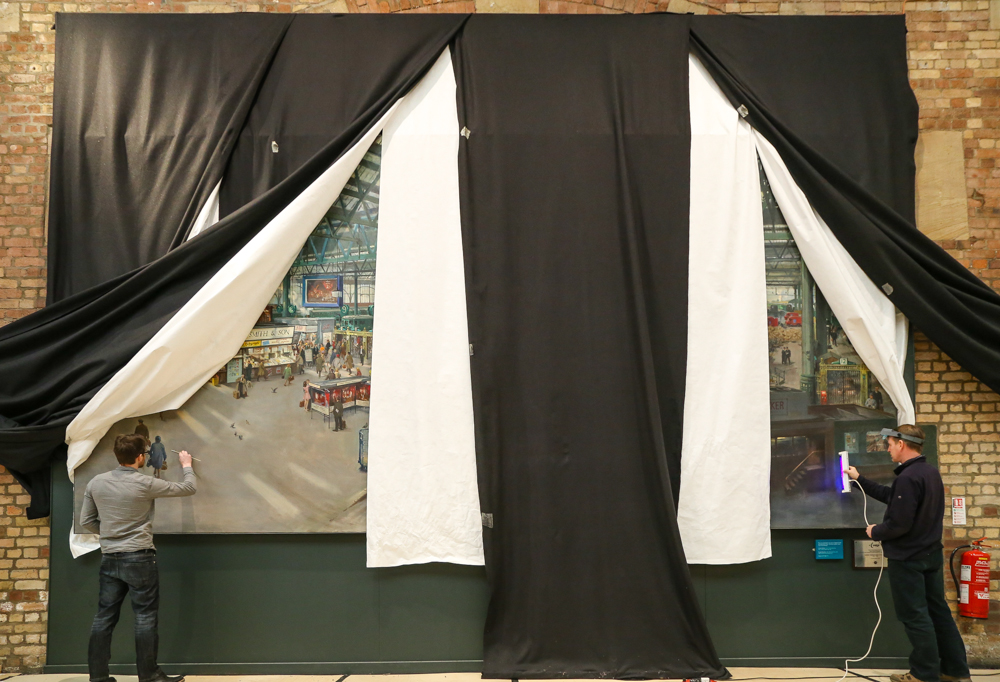
The impact of the collision had not just torn the painting. It had forced a section of canvas against one of the supporting wooden stretcher bars at the rear, causing the loss of some paint. This would have to be replaced, but the new paint would form a sharp contrast with the original. The painting had been on display for nearly fifty years and inevitably was no longer as bright as Cuneo had intended. To ensure that the original and replacement oils matched, the conservators’ first task was clean the surface of the painting. David and Mike painstakingly removed the layers of dirt, using a triammonium citrate solution and occasionally ammonium hydroxide, applied with cotton buds, a mammoth task considering the size of the canvas.
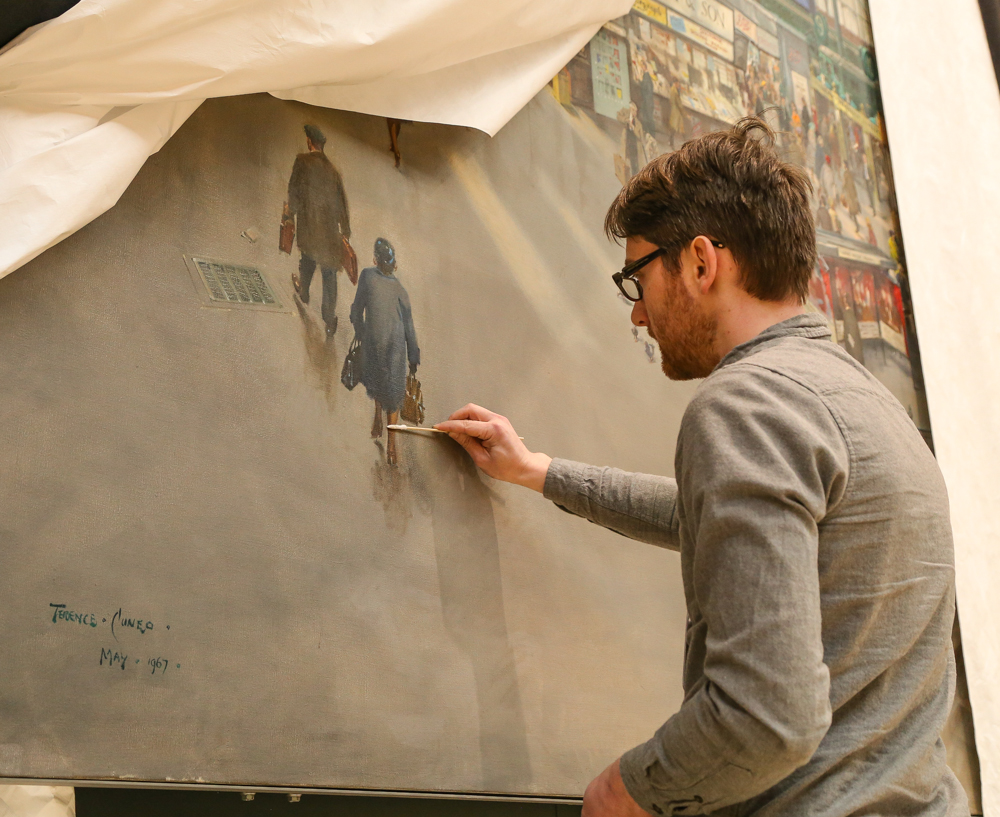
Next the conservators began to repair the tear. First they consolidated the area around the damage, using an isinglass adhesive to prevent any further loss of paint where the canvas had torn. Then they treated the canvas itself. The impact had distorted the canvas and caused it to bow inwards, so it was brought back into plane using pressure and low heat treatments.
The next job was to bind each individual strand of the broken canvas threads together again. They were aligned and joined with a polyamide, gradually at first then more tightly, until the tear had all but disappeared. This was one of the most demanding stages of the conservation, as David and Mike had to work from both sides of the canvas, so the painting had to be repositioned several times. The tear was then patched on the reverse of the canvas, using non-woven polyester and an EVA (ethylene vinyl acetate) adhesive film. With the canvas repaired the lost paint was replaced and the evidence of the tear was barely visible.
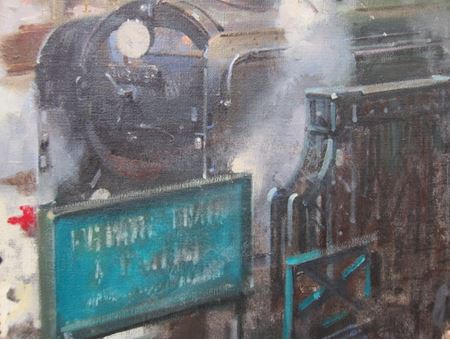
There was one more major conservation decision to make. The examination and cleaning had revealed marks on the painting’s surface, which we had initially thought had been caused by something being splashed onto it, perhaps a sugary drink. Closer inspection by David and Mike revealed that most of the marks were actually discoloured varnish, applied to protect the painting’s surface and provide an even finish. Under examination by ultraviolet light, they discovered that there were some areas that had not been varnished at all. This is hardly surprising when one considers that, on its completion, Terence Cuneo and his assistant, Anthony Kerr, had to varnish the massive canvas quickly.
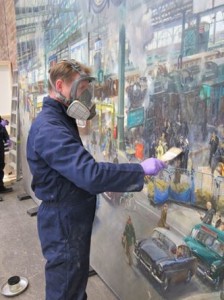
We discussed the options for restoring the varnish and consulted with the artist’s daughter, Carole Cuneo, who had been able to advise on her father’s working methods and the materials that he used. Together we agreed to completely remove the yellowed original varnish and replace it. David and Mike used propanone to remove the varnish, calculating at the end of the job that it had taken them 50 days to complete this work and to clean the surface. The varnish was then replaced with a conservation standard substitute, made of xylene and Paraloid B72 resin. This, combined with the earlier cleaning, had the effect of significantly increasing the brightness of the paint and restoring the vibrant original colours.
Next, the hoarding was taken away in preparation for the final, difficult task of rehanging the painting. Because of its great size, the canvas had lost its tension and was slightly distorted in some areas, so it was tightened with the insertion of keys – wedges – in the corners at the rear. Then, with David and Mike’s assistance, the painting was hung back on the wall by a team of museum staff.
Now, Terence Cuneo’s Waterloo station is back on exhibition once more in Station Hall, where it is daily admired and appreciated by crowds of museum visitors.
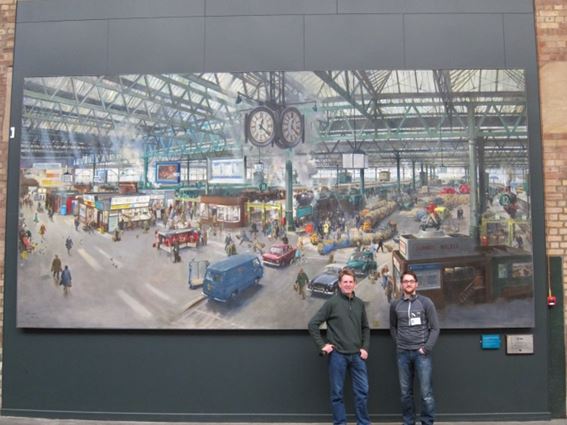
Just wonderful
It’s fantastic to see the painting has a new lease of life. My mother and father worked at the museum, at the time it was painted and are both in the painting. I used to live spotting them when I visited the museum as a child and look forward to bringing my children in The future to spot their grandparents. The museum has changed so much over the years and I love the fact that this picture still remains.
According to Cuneos’ autobiography, “The mouse and his master” the assistance on the painting was provide by Cuneo’s good friend the Canadian singer Edmond Hockeridge, or have I got that wrong? What a wonderful body of work he produced and he is nowhere as revered as he should be.